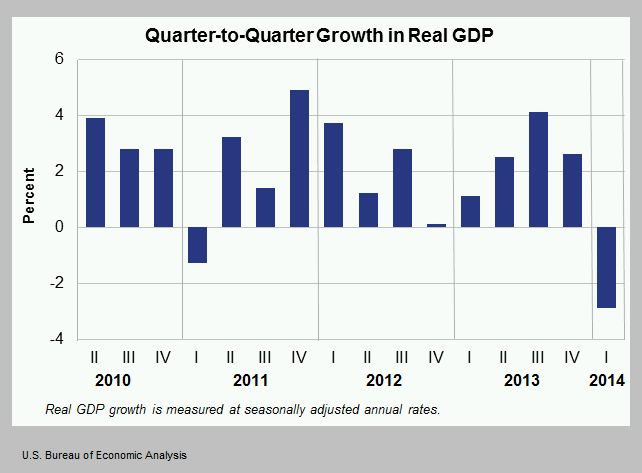Not Inflation, But Deflation
The Elliott Wave Financial Forecast warns that the contracting U.S. economy signals deflation ahead
In June, the U.S. government, revising its previous number, reported that the economy shrank by 2.9% in the first quarter of 2014.
The steep plunge caught the bulls by surprise.
It was substantially worse than the preliminary forecast
for a 1.0% contraction, which itself was a far cry from the
initial 0.1% growth forecast in April.
As you can see on this chart, the last time the economy shrank was Q1 of 2011 (a 1.3% dip).

The [2.9%] decline was the sharpest since growth tumbled 5.4% in the first quarter of 2009 during the Great Recession. It was also one of the worst falloffs outside of a recession since 1960.
USAToday, June 25
The Elliott Wave Financial Forecast, the monthly
report issued by Elliott Wave International, the world’s largest
financial forecasting firm, which is well-known for calling
into question many mainstream forecasting methods, holds a
drastically different outlook from the government. If you
too don’t trust the government projections, EWI is a good
source of contrarian-minded research and analysis.
Financial Forecast co-editors Steve Hochberg and
Peter Kendall warn that investors are dangerously discounting
the potential for a market selloff. They say the economy is
slowly contracting and winding its way toward outright deflation,
and the recent government revision is evidence of deflation
in action. In their recent issues of the Financial Forecast,
they have documented more than two dozen measures of extreme
investor optimism, a classic reversal indicator for technical
analysts.
After the government’s Q1 revision, the stock market hovered in positive territory. What’s more, the Consumer Confidence Index registered a six-year high.
But Hochberg and Kendall believe, in spite of all the optimism, that this latest revision should raise concerning questions among investors about the sustainability of today’s exuberant psychology — especially now that economic growth is inconsistent with the prevailing psychology. When so many sentiment indicators align in one direction, it’s a good time to check in on what the opposite side of the trend might look like. After all, markets never go in the same direction forever, and they tend to reverse alongside extremes in sentiment. Investors who are aware of and prepare for such turning points dramatically increase their chances of surviving them.
Click here for specific forecasts and analysis from Hochberg and Kendall’s latest, July Financial Forecast. You will get free access to a big chunk from their latest issue, complete with labeled technical charts.
This
article was syndicated by Elliott Wave International and
was originally published under the headline (Video) Is That Deflation Knocking on the Door?.
, that, I don’t think the dollar has acautl strength as opposed to mere strength relative to other currencies. Once the other countries can no longer afford to buy our debt – probably next year – we will have hyperinflation. (Of course, by then we’ll have hyperinflation elsewhere, as well, as the other countries sell our paper to reclaim their own. Thing is, everybody ran their printing presses.) Eventually, everybody will shut down the printing presses and come out with a new currency – possibly a world currency or basket of world currencies like the Amero – and things will stabilize, but the in between portion will be nasty. But as long as “commodities” or “gold” are acautlly pieces of paper, they mean as little as dollars and yen. If you are talking about buckets of wheat in your basement, then yeah, “commodities” will be very helpful during the nasty in between period.